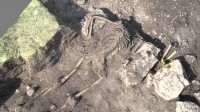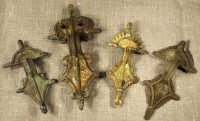 Archaeologists have found yet another Pompeii, you guys! As usual, it’s nothing at all like Pompeii, but it is a fascinating slice of life and violent death in the Scandinavian Migration Period. An excavation of the Iron Age Sandby ringfort on Öland, an island off the southeastern coast of Sweden, has unearthed five skeletons felled by violence and then left untouched until now. No volcanoes or spectacular feats of preservation are involved, but the remains do capture a moment frozen in time that hasn’t been captured anywhere else. During this period Scandinavians cremated their dead so very few whole body remains have been found at all, never mind a whole group of them left unmolested for 1,500 years.
Archaeologists have found yet another Pompeii, you guys! As usual, it’s nothing at all like Pompeii, but it is a fascinating slice of life and violent death in the Scandinavian Migration Period. An excavation of the Iron Age Sandby ringfort on Öland, an island off the southeastern coast of Sweden, has unearthed five skeletons felled by violence and then left untouched until now. No volcanoes or spectacular feats of preservation are involved, but the remains do capture a moment frozen in time that hasn’t been captured anywhere else. During this period Scandinavians cremated their dead so very few whole body remains have been found at all, never mind a whole group of them left unmolested for 1,500 years.
The scene dates to the 5th century, the beginning of a transitional period after the decline of Roman power characterized by mass migrations of Germanic and eastern European peoples. The Migration Period (400 – 700 A.D.) saw a great deal of violence as populations clashed, and the ringforts on Öland (there are 19 in total) were built to defend small farming and livestock raising communities from raids. There was also something of a wealth boom on Öland during the Migration Period — gold and other expensive artifacts have been found in Sandby and other forts — which made it an ideal target for raiders.
The walls were built high and defenders patrolled the parapets. In the middle of the fort interior were multiple small thatched roof dwellings which housed one family each. The builds closer to the walls were used to store food supplies and stable livestock. The people who lived in the ringfort ate comparatively well, a meat-based diet relying on their stock supplemented by trade goods like grains and cereals.
One night in the 5th century, those walls and defenders failed. Lund University osteologist Helene Wilhelmson:
“I think they were surprised. There are so many bodies and two of them are lying by the door as if they were running for the door and people were coming in. They’re lying very close to each other so I think that they were just ambushed in some way, and people were running into the house, trying to kill them and they almost didn’t have a chance. There are so many bodies, it must have been a very violent and well-organized raid.”
The five bodies were all found in a single 62-square-meter house inside the courtyard of the fort. A previous excavation unearthed the house and its door. Two skeletonized feet were peeking out of the doorway. When the team returned the next season, they dug a trench adjacent to the feet and uncovered the first body. It was an adult man lying on his back bearing sharp force trauma wounds to his head and shoulder. He had been killed on the spot and left where he fell. Another man was found lying face down on his stomach. Archaeologists don’t know if he fell that way or if he was flipped over by his killers as a sign of disrespect.
 When the first round of excavations began in 2010 to ward off looters who had been spotted scouring the spot, archaeologists found six beautiful gilded silver and bronze buckles. That means the raiders who killed these five people left riches behind, which is unexpected. It also means the site wasn’t plundered after its destruction, which is also unexpected.
When the first round of excavations began in 2010 to ward off looters who had been spotted scouring the spot, archaeologists found six beautiful gilded silver and bronze buckles. That means the raiders who killed these five people left riches behind, which is unexpected. It also means the site wasn’t plundered after its destruction, which is also unexpected.
Wilhelmson again:
“It’s such a terrible massacre that, yeah, it completely destroyed the fort and everything in it. I don’t think anyone dared to go near it for a very long time. It’s more of a frozen moment than you usually find in archaeology. It’s like Pompeii: something terrible happened and everything just stopped. It’s pretty much just a day in the life in the Migration Period and that’s completely unique. We have nothing to compare it with actually.”
Only one percent of the entire fort area, just a few houses of the 54 inside the fort walls, has been excavated thus far and the partial remains of seven other skeletons have already been found, so it’s likely archaeologists will find more bodies, perhaps even hundreds of them, when the fort is more fully explored.Meanwhile, the team is now photographing the killing house in great detail so accurate 3D models can be made to reconstruct the entire crime scene and hopefully determine what happened step by step.
[youtube=http://youtu.be/WMoIWk0rjE8&w=430]
:skull:
This is so wicked. I hope all the -ologists have a field day with this. (No pun.)
One has to wonder why someone would raid a fort, murder the inhabitants and not pillage the gilded silver and bronze buckles. What’s up with that?
One possible explanation, offered by one of the archaelogists excavating the site, is that it was a raid by neighbouring groups. The fort is the only one on Öland located directly by the shoreline, not close to any good arable land. It might have been erected by mercenaries returning from service with the Roman empire (there is plentiful archaelogical and literary evidence that substantiates the theory that Scandinavians of the time were frequently employed by the Roman army). Land being in short supply on Öland, the homecomers might have decided to make a show of their wealth ans status by erecting a new fort on the island. Possibly conceived as a very real threat to the local communities, given the veterans’ military skills and relative rootlessness in a farm-based society, they may have been attacked by the neighbours. This would explain the seemingly wholesale slaughter (even the livestock seems to have been killed or left to die) and lack of plunder. It could also explain why the victims were not buried once the attackers had left – all was left as a warning to other bands of homecomers.
That is a fascinating hypothesis. Have they discovered any corroborating evidence, like, say, Roman weapons, in the fort itself? If that is how it went down, that might explain why the valuable goods were never looted, because the locals deliberately avoided the place.